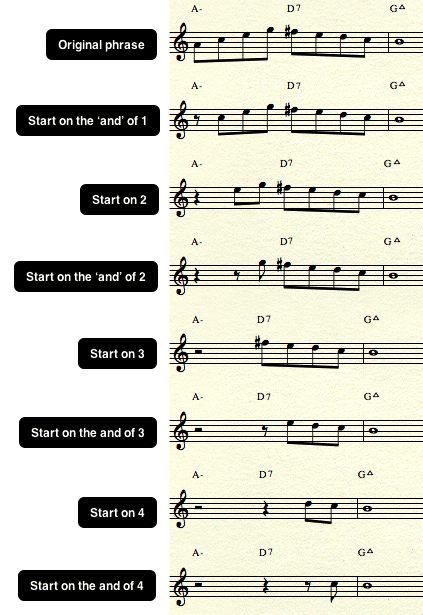The harmonic and melodic aspects of practicing jazz improvisation take up the bulk of our time. Consequently, developing a strong sense of time falls by the wayside. I’m as guilty as anyone else, thinking that somehow, it would just take care of itself. Unfortunately, things don’t work that way…
The people who have “great time” did not arrive there by chance. They focused intently on achieving a deep understanding and a working knowledge of time through hours of dedicated practice. Use the following steps and you’ll be well on your way.
Step 1: Learn to hear metronome clicks as 2 and 4
Set your metronome to 60 bpm. After a click goes by say out-loud, “1.” So, it will go something like this: “click”…”1”. This forces your ear to hear the next click of the metronome as beat 2.
Next, try verbalizing all the beats. After a click, say “1” and then during the next click say “2.” Then say “3,” followed by saying “4” in unison with the click of the metronome. Looks like this: Hear a click…then say “1”, Hear a click while simultaneously saying “2”…Say “3”…Hear a click while simultaneously saying “4.”
Once you get confident verbalizing with the clicks, move the voice to your mind. So, instead of saying each beat number, hear the numbers and clicks in your mind. Practice hearing the beat numbers and clicks in your mind until it is second nature to hear the clicks on 2 and 4.
Gradually, increase the tempo a few beats per minute at a time. If you started on 60bpm, progress to 63 or 65, making sure to stay at a tempo that you can still confidently hear the clicks on 2 and 4. Keep increasing the tempo, a bit at a time, spending several minutes on each increase until you reach somewhere around 104bpm.
It’s not as difficult as it sounds to begin hearing this way. Within a few days of working on it, it will be almost at easy as hearing the clicks as 1 and 3.
Step 2: Learn to play with the metronome clicks on 2 and 4
“I have at times used a metronome on 2 and 4. I get depressed when I do it because I rush. It [playing with a metronome on 2 and 4] does help.” – Michael Brecker
After you can comfortably hear the metronome clicks as beats 2 and 4, select a piece of jazz language you’ve transcribed. Perhaps a ii V line that you’ve acquired from one of your favorite player.
Now, set the tempo to 60bpm and play the line with the metronome on 2 and 4. Use the same techniques that you used previously to hear the clicks as 2 and 4. If you accidentally turn the beat around, making the clicks 1 and 3, don’t worry about it. Just stop and recalibrate your ear to hear them again as 2 and 4.
Just as you did with the hearing exercise, gradually increase the tempo a few beats per minute at a time until you get up to 104bpm. You can always go faster in the future, but 104bpm is a good starting place to aim for.
It’s tricky at first, but keep at it. Practicing with 2 and 4 in this manner will help you lock in with the rhythm section and you’ll notice positive results in your playing nearly right away. And it’s not limited to practicing lines. I used a line for the sake of illustration purposes, but you could just as easily practice your scales, a tune, or anything else your’re working on in the same way. Like Brecker said, practicing with a metronome on 2 and 4 helps. If it helped him, it will help anyone on the planet.
Step 3 : Learn to start phrases anywhere in a measure with the metronome on 2 and 4
“I developed the ability to start anywhere in the bar and it lent to a whole new attitude of constant variation. I would start with the first bar, not starting it on one but starting it on the ‘and’ of four or the ‘and’ of three…”-Joe Henderson
The next step in developing a stronger sense of time is to acquire the ability to start phrases in different parts of the bar. Breaking down the bar into eighth notes is the simplest way to approach this.
For this exercise, again select a piece of jazz language you’ve transcribed. If it’s not already, adjust the line so that it’s comprised of 8 eighth notes as in the example of the original phrase below. Now set your metronome to a slow tempo, maybe 60bpm-72bpm. Before you play anything, hear the clicks as beats 2 and 4. Then play your original phrase. Play it for two minutes straight. Using a timer helps keep you on track if you tend to drift.
After 2 minutes, remove the first eighth note and play the new phrase that begins on the ‘and’ of beat 1 for two minutes, while the metronome ticks away on 2 and 4. Continue to remove eighth notes and spend two minutes on each new phrase until you’ve gone through all eight possibilities as illustrated in the following example.
In a measly 16 minutes you’ve started to internalize what it feels like to start phrases on all parts of the measure when it’s divided by eighth notes. After working on this exercise for a while, it will be natural for you to generate phrases from all parts of the bar.
The subtle power of 2 and 4
It’s simple in theory, and frustrating in practice.
Start by learning to hear the clicks as 2 and 4. Next learn to play a simple eight-note phrase over it. Then truncate the phrase an eighth note at a time to learn how to start lines from anywhere in the measure.
Learning to practice with a metronome on 2 and 4 is challenging for everyone. Some excellent players have told me that even after years of practice, they still have trouble not flipping the beat around when they practice this way. Don’t get frustrated if it’s difficult at first. Stick with it and you’ll notice huge gains in your sense of time.













